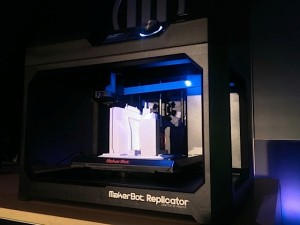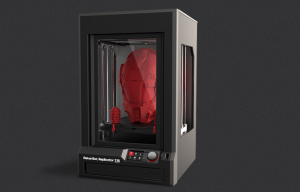Makerbot hosted its traditional effusive press conference ahead of the opening day of International CES at 4pm yesterday afternoon, unveiling its new product line. It had been rumoured something big was coming from the NY based 3D printing company, and so it came to pass. As usual, Makerbot surpassed expectations (generally along the lines of “here comes the Replicator 3 with noticeable improvements following the acquisition by Stratasys”) and launched three new 3D printers together with a host of desktop and mobile apps.
Making the point that this is MakerBot’s 5th consecutive year at CES, Bre Pettis, the gregarious host of the press conference, also noted that the company’s first exhibit at CES, back in 2010, featured the only 3D printer at the show. This year however, they are part of a dedicated 3D printing zone with a vastly improved product offering in four short(!) years.



After the hardware, MakerBot also announced some new apps, including MakerBot Desktop and MakerBot Mobile, which provide a complete 3D printing solution to discover, manage and share 3D prints – from your desktop computer or a mobile device. This availability to your 3D printing files, accessed via a personal MakerBot Cloud Library, allows users to explore Thingiverse, prepare files for printing, and most importantly, remotely monitor and control a MakerBot Replicator 3D Printer. MakerBot Desktop is expected to be available 3 February 2014, while MakerBot Mobile is expected to be available on IOS in the spring and then on Android later in the year.
Then came the introduction of the MakerBot PrintShop billed as a new model and collection-based offering to provide an easy entry into 3D printing models that can be used for personal use, collecting and giving. MakerBot PrintShop is a tablet-based fun, easy and free way to create and 3D print unique signs, jewellery and much more. No 3D design skills are needed to use MakerBot PrintShop. Users can create and 3D print without a learning curve that often comes with developing 3D design skills, the premise being to make 3D design and 3D printing even easier for everyone. PrintShop works with all MakerBot fifth generation printers and is free to all MakerBot users. This possibly suggests that for anyone with a Rep 2 (or earlier model) it may not work and for anyone with any other type of 3D printer, it may not work and you may need to pay to use it.
Similarly the MakerBot Digital Store has been developed to provide a place that offers original, fun and collectible digital content directly to the end user. The MakerBot Digital Store is only available for the MakerBot fifth generation desktop 3D printers and the MakerBot Replicator 2 (4th generation), with all content being “Makerbot Verified”. It is a place where customers can purchase “high-quality, delightful, printable and paintable digital 3D models and collections” that effectively turns any new or 4th Gen MakerBot Replicator “into an in-home entertainment device and completely redefines the distribution channel: there is no packaging, no shelving requirements, no distributor/retailer mark-up, and the customer can print as many copies from the digital file as they want.” Model pricing is based on individual digital 3D files (.x3g and .makerbot) or by the collection, each can be printed as many times as you want; prices start at $0.99 per file or $9.99 for a collection and are exclusive to the MakerBot Digital Store. Current collections include: Around TownTM, Chunky TrucksTM, The Cosmic CadetsTM, Dragons of GlastonburyTM, Famous FlyersTM and PetPalsTM.
So there we have it — MakeBot’s 2014 revelations for 3D printing. The hardware covers all the bases, but also kind of feels like a step backwards too in some respects targeting different markets with different platforms. However in terms of the “Ecosystem” the company is developing it works; whether it quite “fulfils the vision of a 3D printer for everyone,” as noted by Bre, quite yet, is questionable — both in terms of price, materials and capabilities, but they are certainly still moving in the right direction. And in terms of laying strong foundations with consumers, the Digital Store is inspired, it won’t take off quite yet, it’ll be a slow burn and Thingiverse is likely to dominate the content landscape for a while longer, but I have a suspicion that the DigitalStore, in a couple of years time, will be very significant.


